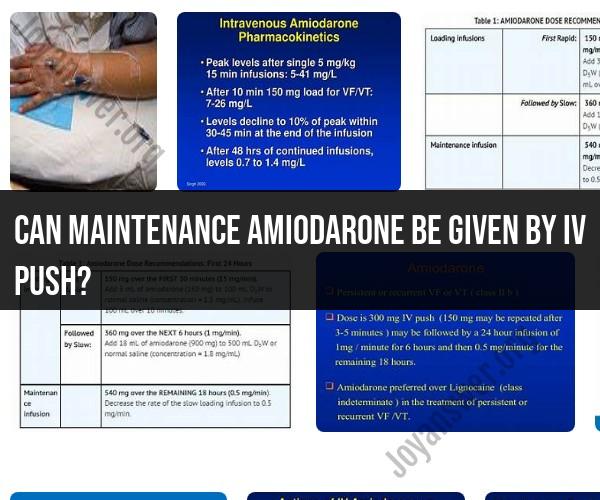Can maintenance amiodarone be given by IV push?
Maintenance amiodarone is typically not administered by IV push (intravenous push) due to its potential for causing adverse effects and the need for precise dosing and monitoring. Instead, it is usually administered as a slow intravenous infusion over an extended period. This method allows for better control of the rate of administration and minimizes the risk of serious side effects associated with amiodarone.
Here are some key considerations regarding the administration of maintenance amiodarone:
Slow IV Infusion: Maintenance amiodarone is usually administered as a slow IV infusion, often over a period of several hours. This slow rate of administration helps reduce the risk of adverse effects on the heart and blood pressure.
Precise Dosage: The dosage of amiodarone is carefully calculated based on the patient's condition, weight, and other factors. Precise dosing is crucial to achieving the desired therapeutic effect while minimizing the risk of toxicity.
Monitoring: Patients receiving maintenance amiodarone require close monitoring of their heart rhythm, blood pressure, and other vital signs during and after the infusion. Regular electrocardiograms (ECGs) may be performed to assess the effect on the heart's electrical activity.
Potential Side Effects: Amiodarone has a long list of potential side effects, including bradycardia (slow heart rate), hypotension (low blood pressure), pulmonary toxicity, liver dysfunction, and thyroid problems. Administering the medication slowly and monitoring the patient's response is essential to detect and manage any adverse effects promptly.
Compatibility: Maintenance amiodarone is typically diluted in a compatible IV solution (e.g., normal saline) before administration. Compatibility with the diluent should be confirmed, and the solution should be prepared under aseptic conditions.
Healthcare Professional Administration: The administration of maintenance amiodarone should be carried out by trained healthcare professionals, such as nurses or pharmacists, in a clinical setting. They are responsible for calculating the correct dose, preparing the infusion, and closely monitoring the patient.
Patient Education: Patients receiving amiodarone should be educated about the medication, its potential side effects, and the importance of regular monitoring. They should also be aware of any dietary restrictions or other precautions.
It's important to note that the use of amiodarone is typically reserved for patients with serious, life-threatening ventricular arrhythmias or atrial fibrillation/flutter that have not responded to other treatments. The decision to prescribe and administer amiodarone is made by a healthcare provider based on the patient's specific medical condition and individual risk factors.
If you have questions or concerns about the administration of amiodarone or any medication, consult with a healthcare provider or pharmacist for guidance and clarification.
Administering Maintenance Amiodarone: IV Push and Considerations
Amiodarone is a class III antiarrhythmic medication that is used to treat a variety of cardiac arrhythmias, including ventricular fibrillation and ventricular tachycardia. It can be administered intravenously (IV) as a bolus or as an infusion.
Maintenance amiodarone is typically administered as an IV infusion over 24 hours. However, it can also be administered as an IV push every 6-8 hours.
Considerations for administering maintenance amiodarone as an IV push:
- Amiodarone is a highly lipophilic drug, which means that it is very well absorbed into tissues. This can lead to a long half-life and a delayed onset of action. Therefore, it is important to be patient when administering amiodarone and to monitor the patient closely for response.
- Amiodarone can cause hypotension and other cardiovascular side effects. It is important to monitor the patient closely while administering amiodarone, particularly if the patient has any underlying cardiovascular conditions.
- Amiodarone can also interact with a number of other medications, including warfarin, digoxin, and lithium. It is important to be aware of these interactions and to monitor patients for any potential problems.
Safe Practices for Delivering Amiodarone as an IV Bolus
When delivering amiodarone as an IV bolus, it is important to follow safe practices to ensure that the medication is delivered safely and effectively.
Here are some tips:
- Use a sterile syringe and needle.
- Draw up the amiodarone into the syringe first.
- Then, draw up the saline solution into the syringe.
- Gently mix the amiodarone and saline solution together.
- Administer the medication slowly and carefully.
- Monitor the patient closely for any adverse reactions.
Amiodarone IV Push: Dosage, Monitoring, and Potential Side Effects
The typical dosage for an amiodarone IV push is 150-300 mg, administered over 10 minutes. The maximum infusion rate is 30 mg/min.
Patients receiving an amiodarone IV push should be monitored closely for the following:
- Hemodynamics: Vital signs, including blood pressure and heart rate, should be monitored closely. Hypotension is a common side effect of amiodarone, and it may be necessary to administer fluids or vasopressors to maintain blood pressure.
- Cardiac rhythm: The patient's cardiac rhythm should be monitored closely to assess the effectiveness of the amiodarone and to identify any potential side effects, such as proarrhythmia.
- Adverse reactions: Patients should be monitored for other potential adverse reactions to amiodarone, such as bronchospasm, nausea, and vomiting.
Potential side effects of amiodarone include:
- Hypotension
- Proarrhythmia
- Bronchospasm
- Nausea
- Vomiting
- Diarrhea
- Headache
- Dizziness
- Fatigue
- Photosensitivity
- Thyroid dysfunction
- Pulmonary fibrosis
- Hepatotoxicity
If you have any questions or concerns about administering maintenance amiodarone as an IV push, please consult with a physician or pharmacist.













